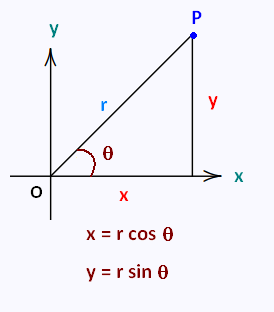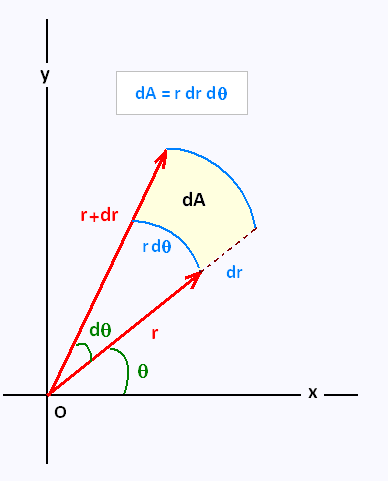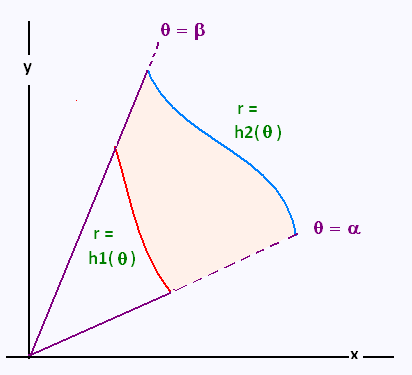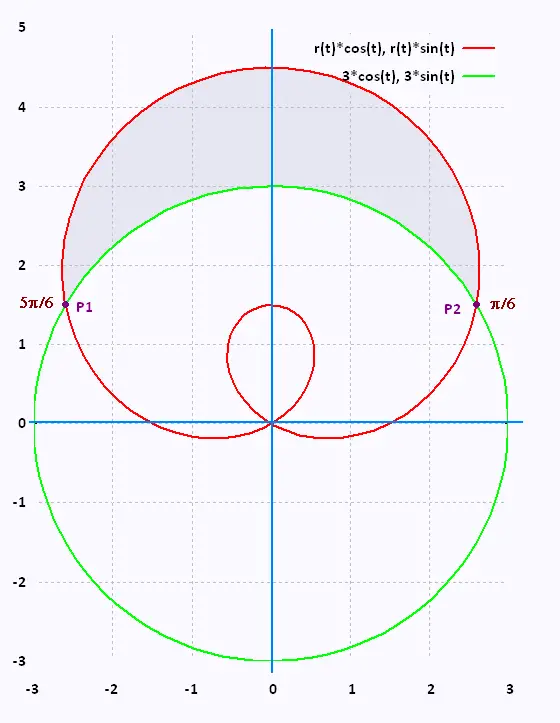Calculus III
Contents
3 Dimensional space
Partial derivatives
Multiple integrals
Vector Functions
Line integrals
Surface integrals
Vector operators
Applications
© The scientific sentence. 2010
|
|
Calculus III:
Polar coodinates system
Polar Coordinates
The area element in polar coordinates
Double integrals in polar coordinates
1. Polar coodinates system

The polar coordinate system is a two-dimensional coordinate system in which each point on a plane is determined by a distance from a reference point and
an angle from a reference direction.
The reference point (O) is analogous to the origin of a cartesian system. It is called the pole. The ray from the pole in the reference direction (x-axis) is the polar axis. The distance from the pole to a point(x,y) is called the radial coordinate or radius (r), and the angle (θ) is the angular coordinate, polar angle, or azimuth.
Polar coordinates are a different way of describing points in the plane. The polar coordinates
(r, θ) are related to the usual rectangular coordinates (x, y) by
x = r cos θ, y = r sinθ
The related equations are:
r2 = x2 + y2,
tan(θ) = y/x
2. The area element in polar coordinates

In polar coordinates the area element is:
dA = r dr dθ.
3. Double integrals in polar coordinates
Double Integrals Over General Regions need to determine
the region D over to integrate . In the case of this
region D is somewhat circular, using polar coordinates , double integrals are is more easily described.
For instance, a region that is a disk, ring, or a portion of a disk or ring. In these cases using Cartesian coordinates could be somewhat cumbersome.
Let's consider the following integral:
∫∫D f(x,y) dA , where D is a circle of radius 3. So
D = {(x,y)| - 3 ≤ x ; ≤ + 3, - √(9 - x2) ≤ y ≤ +√(9 - x2)}
∫∫D f(x,y) dA =
∫-3+3 ∫- √(9 - x2 √(9 - x2 f(x,y)dy dx
The inner integral involving these limits asks a lot of work to compute.
However, a disk of radius 3 can be defined in polar coordinates by the following simple inequalities:
0 ≤ r ≤ 3, 0 ≤ y ≤ 2π.
So the intagral becomes easier to compute:
∫∫D f(x,y) dA =
∫03 ∫0 2π f(rcosθ,rsinθ)rdr dθ
5. General region in polar coordinates

The general region is defined by the two inequalities:
α ≤ θ ≤ β, h1(θ) ≤ r ≤ h2(θ)
We have then the formula:

5. Examples
Examples 1
Find the integral
∫∫D 3x y dx dy
by converting it into polar coordinates.
D is the portion of the region between the circles of
radius 1 and radius 4 centered at the origin that lies
in the first quadrant.
The region is defined by the two inequalities:
0 ≤ θ ≤ π/2, 1 ≤ r ≤ 4
∫∫D 3x y dx dy =
∫0π/2 ∫14
3 r3 cos θ sin θ dr dθ =
∫0π/2
(3/4) r4|14
cos θ sin θ dθ =
∫0π/2
(3/4)(255)
cos θ sin θ dθ =
(3/4)(255)∫0π/2(1/4)sin(2θ)d(2θ) =
(1/4)(3/4)(255)
(- cos 2θ))|0π/2 =
(1/4)(3/4)(255)(1 + 1) =
(3/8)(255) = 765/3
∫∫D 3x y dx dy = 765/3
Examples 2
Find the integral
∫∫D exp{x2 + y2}dA
.
D is the unit circle centered at the origin.
∫∫D exp{x2 + y2} dA =
∫∫D exp{x2 + y2} dx dy =
∫02π ∫01
exp{r2sin2θ + r2cos2 θ} r dr dθ =
∫02π ∫01
exp{r2} r dr dθ =
(1/2) ∫02π
exp{r2}|01
dθ =
(1/2) ∫02π
(e - 1)
dθ =
(1/2)(e - 1) (θ)|02π
= π(e - 1)
∫∫D exp {x2 + y2} dA = (e - 1)π
Examples 3

By Gnuplot:
reset
set grid
set parametric
r(t) = 1.5 + 3sin(t)
plot [0:2*pi] r(t)*cos(t), r(t)*sin(t), 3*cos(t), 3*sin(t)
We want to retermine the area of the region that lies
inside 1.5 + 3sin(θ) and outside r = 3.
We need first to determine the angles of the two points
of intersection P1 and P2.
They are given by equationg the two equations :
r(θ) = 1.5 + 3sin(θ ), and r(θ) = 3 . So
1.5 + 3sin(θ ) = 3 → sin(θ) = 1/2
Recall:
sin (x ) = a
x = arcsin (a) + 2kπ
x = π - arcsin (a) + 2kπ
k ..., -2, -1 , 0, 1, 2, , ...
Then
θ = π/6
θ = π - π/6 = 5π/6
Therefore
∫∫D dA =
∫∫D dx dy =
∫π/65π/6 ∫31.5 + 3sin(θ) r dr dθ =
∫π/65π/6
(1/2)r2|31.5 + 3sin(θ)
dθ =
(1/2)∫π/65π/6
(1.5 + 3sin(θ))2 - 9
dθ =
(1/2) ∫π/65π/6
(1.5 + 3sin(θ))2 - 9
dθ
=
(1/2) ∫π/65π/6
(9/4 + 9sin(θ) + 9 sin2(θ) - 9 )
dθ
=
(1/2) ∫π/65π/6
(-27/4 + 9sin(θ) + 9 (1/2 - cos(2θ)))
dθ
=
(9/2)
(- θ/4 - cos(θ) - (1/2) sin(2θ))
|π/65π/6
=
(9/2)
(- 5π/24 - cos(5π/6) - (1/2) sin(5π/3)
+ π/24 + cos(π/6) + (1/2) sin(π/3))
=
(9/2)
(- 5π/24 - cos(5π/6) - (1/2) sin(5π/3)
+ π/24 + cos(π/6) + (1/2) sin(π/3))
= - π/6 + cos(π/6) - cos(5π/6) + (1/2) sin(π/3)) - (1/2) sin(5π/3) =
(9/2)(
- π/6 + √3/2 + √3/2 + √3/4 + √3/4 ) =
(9/2)(
- π/6 + √3 + √3/2 )
= (9/2)( - π/6 + 3√3/2)
)
∫∫D dA = - 3π/4 + 27√3/4
|
|